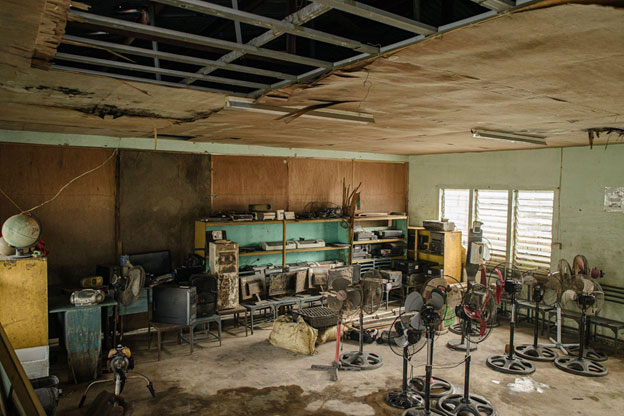UNITED NATIONS, October 30 (IPS) – In 2024, the climate crisis has disrupted schooling for millions of students worldwide, weakening workforces and hindering social development on a massive scale. With extreme weather patterns preventing students from accessing a safe, and effective learning environment, the United Nations (UN) and the Geneva Global Hub for Education in Emergencies (EiE Hub) continue to urge the international community to assist the most climate-sensitive areas in building resilient education systems that empower both students and educators.
On October 28, members of the EiE Hub released a statement that calls on stakeholders and world leaders to center children’s education at the forefront of global discussions at COP30 to be held in Belém, Brazil in November. It is projected that without urgent intervention, tens of millions of children are at risk of falling behind on their education, which threatens long-term economic development and stability.
“Children are more vulnerable to the impacts of weather-related crises, including stronger and more frequent heatwaves, storms, droughts and flooding,” said Catherine Russell, Executive-Director of the United Nations Children’s Fund (UNICEF), in January. “Children cannot concentrate in classrooms that offer no respite from sweltering heat, and they cannot get to school if the path is flooded, or if schools are washed away. Last year, severe weather kept one in seven students out of class, threatening their health and safety, and impacting their long-term education.”
According to figures from UNICEF, approximately half of the world’s school-aged children receive access to quality education, with an estimated 1 billion children residing in countries that are described as “extremely high-risk” to climate shocks and natural disasters. Members of the EiE Hub estimate that at least 242 million students experienced disruptions to their education in 2024 due to climate-related events, with more than 118 million affected by heatwaves in May alone. Beyond hindering learning quality and teachers’ ability to effectively instruct, climate-induced disasters and shocks also increase the risk of school dropouts and expose children to heightened protection risks.
These risks are especially severe in communities across the Global South, where the impacts of climate-induced disasters are most pronounced. Frequent climate shocks devastate local economies, undermine adaptation efforts, and exacerbate pre-existing inequalities. Women, girls, displaced persons, and individuals with disabilities are disproportionately affected—facing higher risks of violence, adverse health impacts, loss of livelihood opportunities, and increased rates of child, early, and forced marriage.
In August, a report published by UNICEF and the UN Economic Commission for Latin America and the Caribbean (ECLAC) found that roughly 5.9 million children and adolescents in Latin America and the Caribbean could be pushed into poverty by 2030 due to loss of education as a result of climate change if governments do not intervene soon. This represents the most optimistic scenario as the projected number of young people pushed into poverty could be as high as 17.9 million.
According to the United Nations Educational, Scientific, and Cultural Organization (UNESCO), the Asia-Pacific region is considered to be the most climate-sensitive environment in the world, in which communities in coastal and low-lying areas are disproportionately impacted by rising sea levels and extreme weather patterns. Additionally, these communities rely on fisheries and agriculture, which are climate-sensitive economies, putting them at further risk.
A World Bank report titled Gender Dimensions of Disaster Risk and Resilience highlights the heightened vulnerability of boys and girls during climate-related shocks and how this impacts them differently. In Fiji, numerous households that lost one or both parents to natural disasters intensified by climate change, underscoring the link between families who experienced the loss of a parent and increased rates of school dropouts and child labor.
The report also found that girls who lost both parents were 26 percent less likely than boys to join the workforce within five years of a disaster and were 62 percent more likely to be married during the same period. In Uganda, the World Bank recorded that the likelihood of engaging in child labor often increases for both boys and girls following a natural disaster.
“If children and young people don’t have the resources to meet their basic needs and develop their potential, and if adequate social protection systems are not in place, the region’s inequalities will only be perpetuated,” said Roberto Benes, UNICEF Regional Director for Latin America and the Caribbean.
Despite this, education systems receive only a small percentage of available climate and government funding. From 2006 to March 2023, it is estimated that only 2.4 percent of funding from multilateral climate action budgets go toward climate-resilience programs for schools. According to EiE Hub, during the last cycle of the Nationally Determined Contributions (NDCs 2.0), less than half of the NDCs met the standards for being child-sensitive, and have therefore been largely overlooked by governments.
EiE Hub calls on governments, donors, and civil society groups to make education a key part of climate action dialogue going forward, particularly in discussions at COP30. The organization highlights the importance of increased investment in climate-resilient education systems—especially in vulnerable and conflict-affected areas—as every USD $1 a government invests in education, national GDP can increase by approximately USD 20.
Additionally, the organization also stresses the need to involve children and youth in climate policymaking and to invest in resilient school infrastructure and climate education. By integrating green skills and climate learning into curriculum, education can become a powerful tool for resilience and climate action.
IPS UN Bureau Report
© Inter Press Service (20251030055835) — All Rights Reserved. Original source: Inter Press Service


